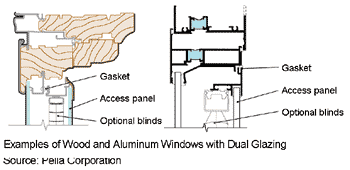Greater Vision: Alternate Window Materials in Commercial Buildings
|
Comparison of Dual
Glazing and
|
Both dual glazing and insulating glass units can accommodate between-glass options such as blinds and muntins. In a dual glazing system the interior glass panel is typically designed as an access panel, allowing blinds/shades to be serviced for maintenance/repair. However, when the blinds in an insulating glass unit break, the entire piece of insulating glass requires replacement.
When blinds are excluded, the difference in cost between a window with insulating glass and one with dual glazing is negligible. The initial price of a between-glass blind is slightly higher than a room-side blind of similar quality. However, between-glass blinds do not have the future life-cycle costs associated with room-side blinds (i.e. cleaning and replacement due to damage).
|
When comparing insulating glass to dual glazing, the only differing acoustic factor is the air space between the panes of glass. The larger air space associated with dual glazing results in less sound transmission through the window and a sound transmission class (STC) rating at least 15% better, with additional improvements in STC as the air space increases.
When sealed insulating glass is broken, the entire unit must be replaced. However, with the large air space between the panes in a dual-glazed window, it is uncommon for both to be broken simultaneously. When the exterior pane is broken, the interior pane remains intact and provides protection or vice versa.
|
Thermal Performance of Insulating Glass and Dual Glazing
|
The above table shows clear dual glazing offers a better total window U-value than clear insulating glass while all other values are the same. When closed blinds are added to the window, dual glazing with between-the-glass blinds offers an 18% improvement in total window U-value and a 43% improvement in solar heat gain coefficient (SHGC) over a window with room-side blinds.
In addition to using layers of glazing and controlling the properties of the spaces between them, the Web site www.efficientwindows.org suggests improving the energy performance of glazing products by changing the chemical composition or physical characteristics of the glazing material by adding a tint or by applying a low-emittance (Low-E) coating to the glazing material surface to reduce heat gain and glare.










